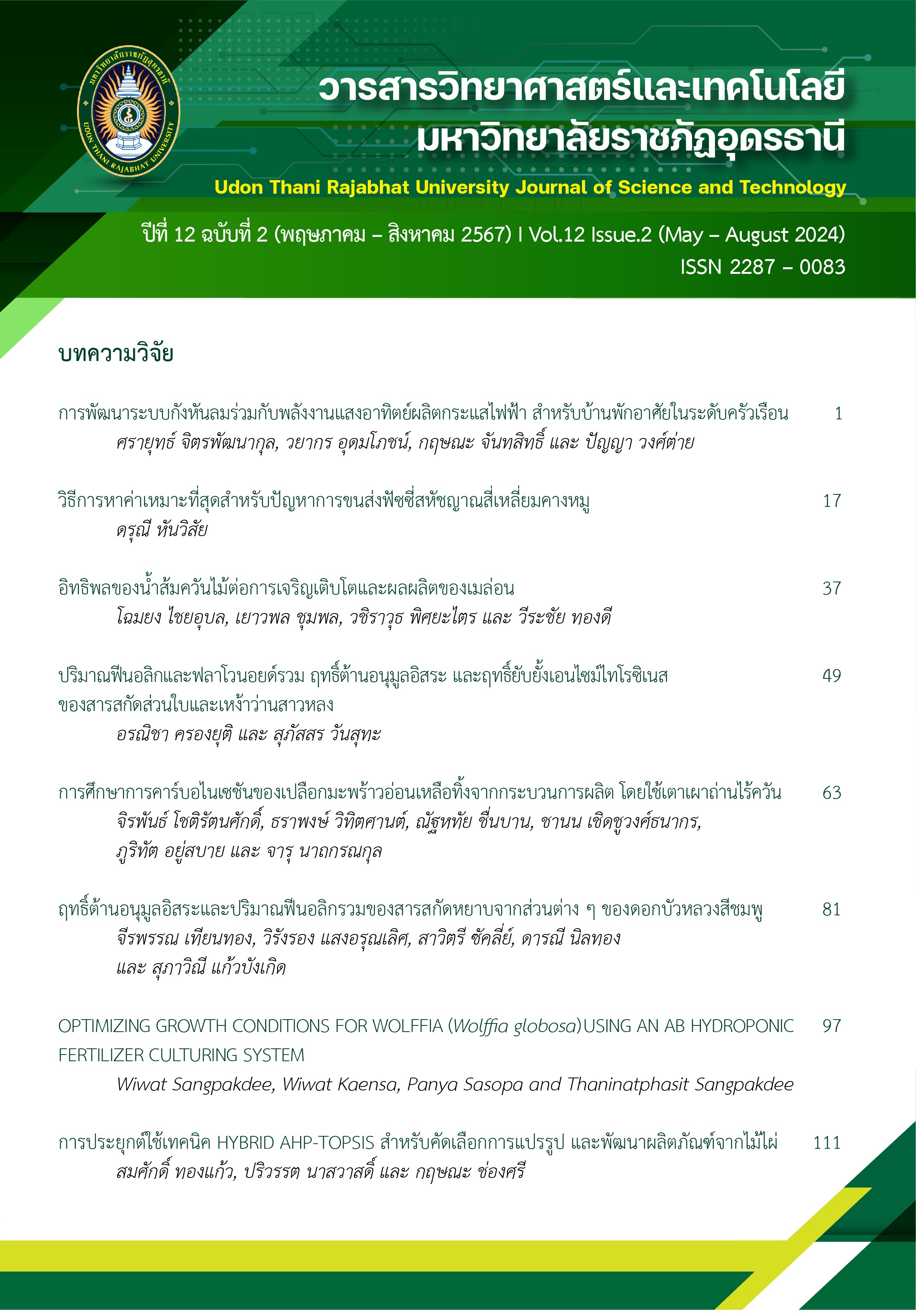A STUDY ON THE CARBONIZATION OF YOUNG COCONUT HUSKS WASTE USING A SMOKELESS CHARCOAL KILN
Main Article Content
Abstract
Currently, Thailand produces and exports over 600 million young coconuts annually. The trimming process of these young coconuts generates a substantial amount of coconut husks as waste which amounts to 600,000 tons of coconut husks per year. In this research, the carbonization of young coconut husks using a smokeless charcoal kiln to produce biochar was investigated. The study aimed to compare the carbonization process and properties of biochar derived from different biomass types, including coconut husks, cassava rhizomes, bamboo, and Leucaena. The results indicated that the average yield of biochar from coconut husks was 35.72% by weight. The comparing results of carbonization from various biomass types and the properties of biochar qualities, it was found that biochar from young coconut husks exhibited similar characteristics to biochar produced from bamboo, a commonly used biomass for charcoal production. In addition, a comparative study was conducted on the use of fuels in carbonization using two different types of fuels: biomass and used engine oil. The findings indicate that while the choice of fuel did not significantly influence the yield percentage of biochar, it did have a notable impact on production costs. Specifically, the use of used engine oil resulted in higher production costs compared to biomass.
Article Details
References
กนกพงษ์ ศรีเที่ยง. (2566). การพัฒนาเชื้อเพลิงชีวมวลอัดแท่งจากเปลือกสับปะรดผสมซังข้าวโพด. วารสารวิชาการพระจอมเกล้าพระนครเหนือ, 33(1), 232–244.
กรกนก โกศล, ศศิธร ศรีอ่อน, พรรณพรรธน์ จำปาแพง และ สายันต์ แสงสุวรรณ. (2566). ไบโอชาร์ (วัสดุมหัศจรรย์) : การสังเคราะห์ พิสูจน์เอกลักษณ์ และศักยภาพการประยุกต์ใช้งาน. วารสารวิทยาศาสตร์และเทคโนโลยี มหาวิทยาลัยอุบลราชธานี, 25(1), 89–104.
เกษตรดิจิทัล. (2564). ข้อมูลพันธุ์ไม้ Bambusa beecheyana Munro. สืบค้นเมื่อ 17 กรกฎาคม 2567, จาก https://data.addrun.org/plant/archives/d2081-bambusa-beecheyana-munro.
โกศล เรืองแสน, อัดชา เหมันต์, หอมหวน ตาสาโรจน์, สิทธิศักดิ์ เริงฤทธิ์, ภัคคิป ไกรโสดา, วิราวรรณ เหมันต์, และ ศิริวรรณ เรืองแสน. (2565). การพัฒนาเตาเผาถ่านไม้หุงต้มมาตรฐานผลิตภัณฑ์ชุมชน. วารสารวิทยาศาสตร์ เทคโนโลยีและนวัตกรรม มหาวิทยาลัยกาฬสินธุ์, 1(1), 1–10.
จุฑาพล จำปาแถม, ลำพูน เหลาราช, ภิตินันท์ อารยางกูร, และ สุรสิงห์ อารยางกูร. (2565). การศึกษาอัตราส่วนที่เหมาะสมและสมบัติถ่านอัดแท่งจากไม้ไผ่. วารสารเกษตรศาสตร์และเทคโนโลยี, 3(3), 81-93.
ณิชาภัทร สิทธิวรนนท์. (2562). ผลของการใช้ถ่านชีวภาพต่อความอุดมสมบูรณ์ของดิน การกักเก็บน้าในดิน และการปลดปล่อยก๊าซคาร์บอนไดออกไซด์. (วิทยาศาสตรมหาบัณฑิต, มหาวิทยาลัยเชียงใหม่).
น้ำฝน ใจดี, ยิ่งยศ จิตจักร และ กฤตยชล ทองธรรมสถิต. (2566). การออกแบบและพัฒนาแบรนด์เพื่อสร้างอัตลักษณ์และเพิ่มคุณค่า ถ่านชีวมวลอัดแท่งของวิสาหกิจชุมชนหนองเลงพัฒนา จังหวัดชลบุรี. วารสารสังคมศาสตร์และวัฒนธรรม, 7(10), 350–363.
ประภา ธารเนตร, พันทิภา โพธิ์พันธุ์ และ กชกร หล้าพรหม. (2565). บทบาทของถ่านชีวภาพต่อการกักเก็บคาร์บอนในดินและการลดการปลดปล่อยก๊าซเรือนกระจกในพื้นที่เกษตรกรรม. แก่นเกษตร, 50(4), 1233–1253.
ปริญญา นูวบุตร, จินดาพร จำรัสเลิศลักษณ์, และ เลิศสถิตธนกร เจริญพร. (2559). ถ่านและน้ำส้มควันไม้จากการคาร์บอไนเซชันของเปลือกไม้และเปลือกผลไม้. วารสารวิทยาศาสตร์และเทคโนโลยี มหาวิทยาลัยมหาสารคาม, 35(5), 519–524.
ปานใจ สื่อประเสริฐสิทธิ์, ศิริวรรณ แก้วสวิง และ อมรประภา ทิศกระโทก. (2563). การผลิตถ่านชีวภาพและเชื้อเพลิงเขียวจากเปลือกทุเรียน. วารสารวิทยาศาสตร์และเทคโนโลยี มหาวิทยาลัยมหาสารคาม, 39(5), 580–586.
ลลิตา เพชรใจหาญ. (2565). ปัจจัยที่มีผลกระทบต่อการผลิตถ่านชีวภาพจากเศษวัสดุเกษตร. (ปริญญาวิศวกรรมศาสตรมหาบัณฑิต, มหาวิทยาลัยแม่โจ้).
วัชรานนท์ จุฑาจันทร์. (2562). การศึกษากระบวนการเผาถ่านและสมบัติของถ่านอัดแท่งจากหญ้าแฝก. วารสารเทคโนโลยีอุตสาหกรรม มหาวิทยาลัยราชภัฏอุบลราชธานี, 9(2), 135–146.
สมมาส แก้วล้วน, ภรณี ศรีรมรื่น, สุรชัย ณรัฐ จันทร์ศรี, พิชัย อัษฎมงคล, และ สินศุภา จุ้ยจุลเจิม. (2564). การผลิตถ่านและน้ำส้มควันไม้จากไม้ไผ่เลี้ยงด้วยเตาเผาถ่านชุมชนขนาด 200 ลิตร ที่ทำงานร่วมกับหัวเผาแก๊สเชื้อเพลิงสังเคราะห์. วารสารวิจัยราชภัฏเชียงใหม่, 22(2), 229-245.
องค์การบริหารจัดการก๊าซเรือนกระจก (องค์การมหาชน). (2565). ค่าการปล่อยก๊าซเรือนกระจก (Emission Factor) รวบรวมมาจากข้อมูลทุติยภูมิ สำหรับการประเมินคาร์บอนฟุตพริ้นท์ขององค์กร. สืบค้นเมื่อ 17 กรกฎาคม 2567, จาก https://thaicarbonlabel.tgo.or.th/tools/files.php?mod=YjNKbllXNXBlbUYwYVc5dVgyVnRhWE56YVc5dQ&type=WDBaSlRFVlQ&files=TXc9PQ.
Dindoruk, B., Ratnakar, R. R., and He, J. (2020). Review of Recent Advances in Petroleum Fluid Properties and Their Representation. Journal of Natural Gas Science and Engineering, 83, 103541.
European Biochar Certificate. (2022). Guidelines for a Sustainable Production of Biochar. Retrieved July 10, 2024, from https://www.european-biochar.org/media/doc/2/version_en_10_1.pdf.
Kant Bhatia, S., Palai, A. K., Kumar, A., Kant Bhatia, R., Kumar Patel, A., Kumar Thakur, A., and Yang, Y. H. (2021). Trends in Renewable Energy Production Employing Biomass-Based Biochar. Bioresource Technology, 340, 125644.
Malyan, S. K., Kumar, S. S., Fagodiya, R. K., Ghosh, P., Kumar, A., Singh, R., and Singh, L. (2021). Biochar for Environmental Sustainability in the Energy-Water-Agroecosystem Nexus. Renewable and Sustainable Energy Reviews, 149, 111379.
Morgan, W. (2024). It’s Not Game over – It’s Game on’: Why 2024 Is an Inflection Point for the Climate Crisis. Retrieved July 16, 2024, from https://www.climatecouncil.org.au/inot-game-over-game-on-why-2024-inflection-point-for-climate-crisis/.
National Aeronautics and Space Administration. (2024). The Effects of Climate Change. Retrieved July 16, 2024, from https://science.nasa.gov/climate-change/effects/.
Seow, Y. X., Tan, Y. H., Mubarak, N. M., Kansedo, J., Khalid, M, Ibrahim, M. L., and Ghasemi, M. (2022). A Review on Biochar Production from Different Biomass Wastes by Recent Carbonization Technologies and Its Sustainable Applications. Journal of Environmental Chemical Engineering, 10(1), 107017.
Sher, F., Iqbal, S. Z., Liu, H., Imran, M., and Snape, C. E. (2020). Thermal and Kinetic Analysis of Diverse Biomass Fuels under Different Reaction Environment: A Way Forward to Renewable Energy Sources. Energy Conversion and Management, 203, 112266.
Yrjälä, K., Ramakrishnan, M., and Salo, E. (2022). Agricultural Waste Streams as Resource in Circular Economy for Biochar Production towards Carbon Neutrality. Current Opinion in Environmental Science & Health, 26, 100339.


